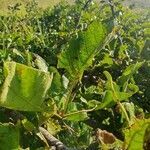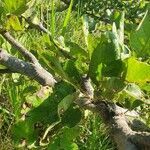Deciduous shrub or tree 2–9 m. high; crown spreading; bark rough, brownish grey.. Leaves mostly 1-foliolate, occasionally some leaves trifoliolate, crowded on short stout node-like branchlets; petiole 0.5–4 cm. long, subterete and shallowly grooved above; lamina obovate, ovate or elliptic, 4–10 cm. long, 2.5–8 cm. broad, obtuse and sometimes retuse at the apex, cuneate or obtuse to somewhat truncate at the base, margin entire or undulate, young ones densely floccose-stellate-tomentose on both surfaces, upper surface later with sparsely stellate and simple hairs, the lower surface remaining whitish densely tomentose with both stellate and simple hairs; midrib and lateral nerves prominent beneath or persistently covered by the indumentum as is also the reticulation.. Inflorescences of spike-like panicles 1–3 cm. long, clustered on short lateral branchlets, ♀ usually in short clusters; axis densely whitish tomentose.. Flowers clustered on the peduncle, subsessile or with pedicels up to 1 mm. long.. Calyx-lobes ovate, 1–1.5 mm. long and broad, tomentose.. Petals elliptic-obovate, 3–5 mm. long, 1.5–2 mm. broad, greenish yellow, unguiculate.. Ovary rudimentary in ♂, 4-locular in ♀, 1 mm. long, densely tomentose; styles 4, glabrous and with peltate stigmas.. Drupe ovoid to oblong-ovoid, 10–14 mm., 7–11 mm. in diameter, somewhat longitudinally ridged, apex with (3–)4 horns showing remains of the original 4 styles, densely stellate-tomentose.
More
A spreading shrub or tree. It grows 2-6 m high. It has many branches and loses its leaves during the year. The trunk and branches are thick. The bark is thick and smooth or rough. It is grey. The leaves are simple and dull green. They often have soft hairs underneath. They are in clusters on short side branches. The flowers are yellow with red patches. The fruit are 1.5 cm long. They are hairy.
It is a tropical plant. In Kenya it grows in open bushland between 300-2,000 m altitude. It is more common at the higher altitudes. It needs soil with plenty of air and usually sandy or rocky. It can grow in arid places.
More
Wooded grassland, semi-evergreen and deciduous bushland, often on rocky sites including lava, at elevations from 300-2,000 metres.



